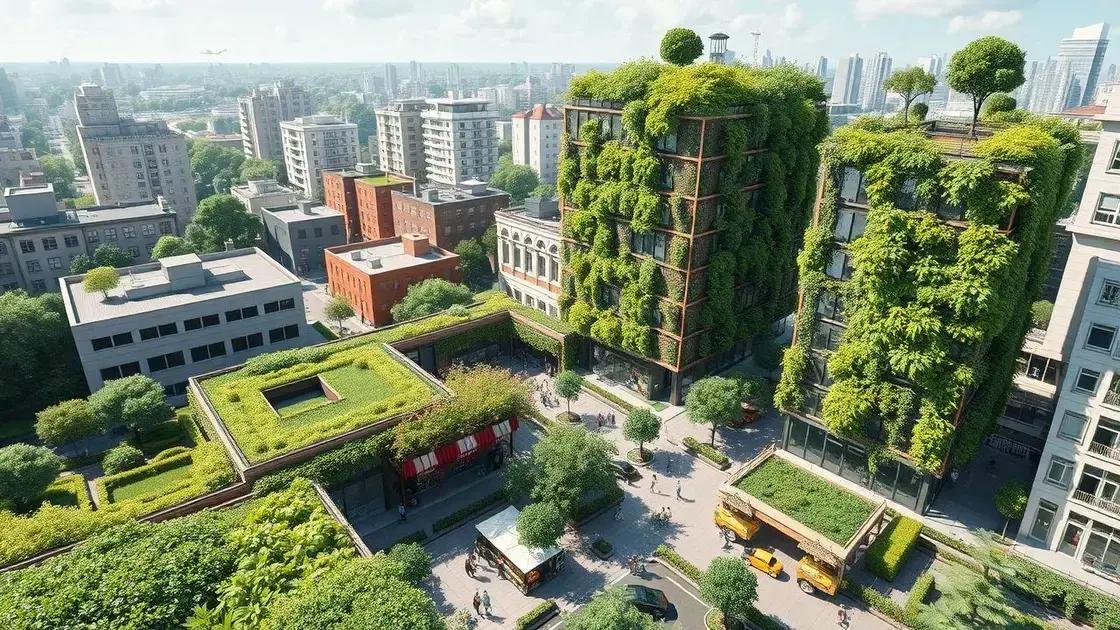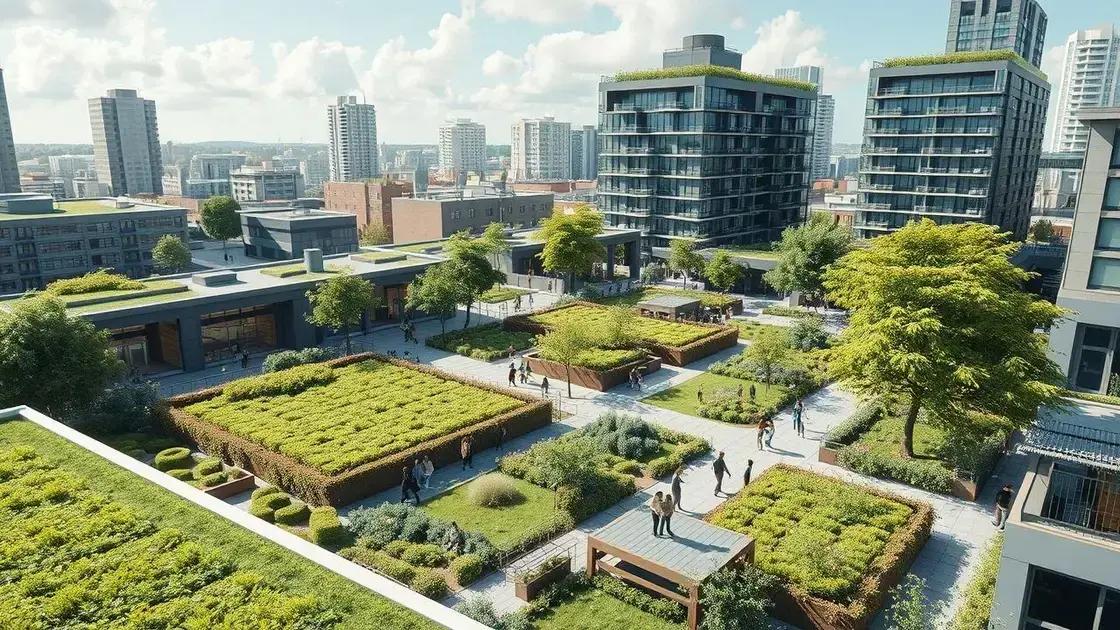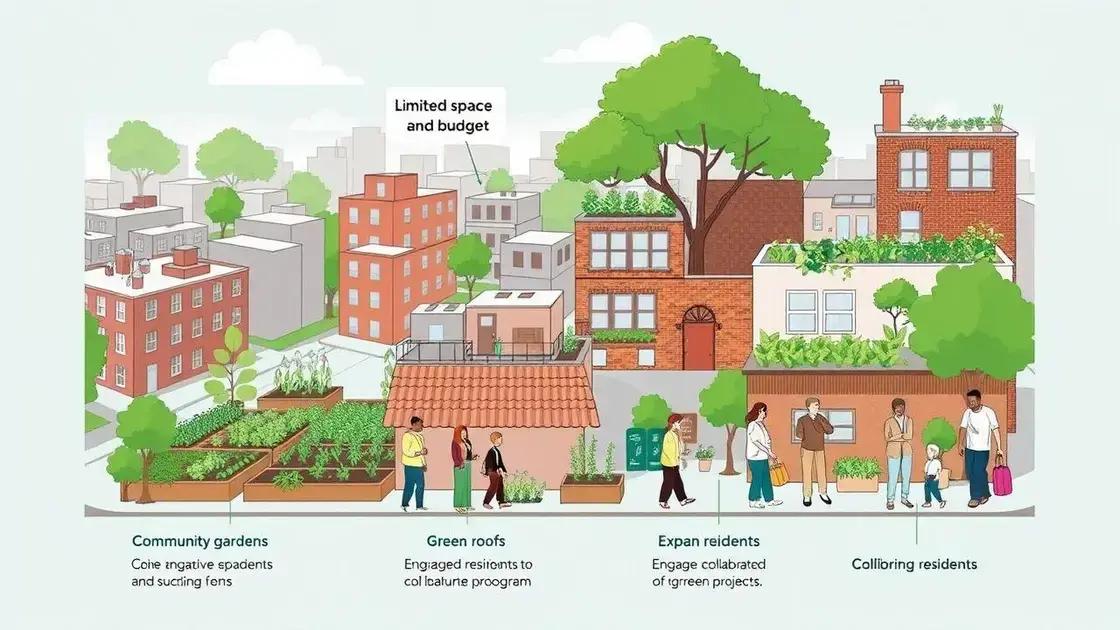Green infrastructure headlines trends reshaping urban landscapes

Green infrastructure refers to the integration of natural systems in urban planning, enhancing environmental health, economic stability, and community well-being while addressing challenges like funding and space constraints.
Green infrastructure headlines trends are crucial in modern urban planning. By incorporating nature-based solutions, cities enhance resilience and quality of life. Ready to explore how this trend transforms our environments?
Understanding green infrastructure
Understanding green infrastructure is essential for creating sustainable urban environments. This concept involves integrating natural systems into urban planning and design. By doing so, cities can improve their resilience against climate change and enhance the quality of life for residents.
What is Green Infrastructure?
Green infrastructure refers to a network of natural and semi-natural features that provide environmental, social, and economic benefits. Examples include wetlands, green roofs, parks, and permeable pavements. These features work together to manage stormwater, reduce urban heat, and improve air quality.
Benefits of Green Infrastructure
Implementing green infrastructure can lead to numerous advantages, including:
- Improved water management
- Reduced heat island effect
- Enhanced biodiversity
- Promotion of physical and mental well-being
The best part is that these benefits not only help the environment but also enhance the aesthetics of urban spaces. As cities grow, green infrastructure provides a balance between human needs and nature.
Moreover, as we learn more about the importance of sustainability, many urban planners are prioritizing this approach. It’s incredible how even small changes, like planting trees or creating community gardens, can have a big impact. The integration of green infrastructure can elevate the urban experience, inviting more people to engage with their environment.
Challenges Ahead
While the benefits are significant, there are also challenges to consider. Implementing green infrastructure often requires planning and collaboration among various stakeholders. Budgets, space, and maintenance are common concerns that cities face.
Nevertheless, as more cities recognize the value of green infrastructure, innovative solutions are emerging. Collaborations with local communities can help address these challenges and ensure that the infrastructure meets the needs of all residents.
In conclusion, understanding green infrastructure is vital for future urban development. It presents an opportunity to enhance city resilience while fostering a better quality of life for everyone.
Current trends in green infrastructure

Current trends in green infrastructure show a growing focus on sustainability and resilience in urban environments. More cities are adopting nature-based solutions that benefit both the ecosystem and the community.
Nature-Based Solutions
Nature-based solutions are becoming popular in urban planning. These methods use natural processes to solve environmental challenges. Some examples include:
- Green roofs: They reduce stormwater runoff and improve air quality.
- Rain gardens: These spaces absorb excess rainwater, preventing flooding.
- Tree canopies: They provide shade, reduce heat, and enhance biodiversity.
By utilizing these solutions, cities can increase their green space and create healthier living conditions.
Community Engagement
Another trend is the active involvement of the community in planning and maintaining green spaces. Programs that encourage citizens to participate in urban gardening or tree planting foster a sense of ownership. This connection to green spaces leads to:
- Enhanced community pride.
- Improved social cohesion.
- Education on sustainability.
As people engage, they can advocate for more green projects, further transforming their environments.
Additionally, technology plays a role in the current trends. Innovations like smart irrigation systems help manage water use more efficiently. Using sensors and data analytics, cities can monitor their green infrastructure’s health and performance. This proactive approach ensures that the installations remain functional and effective.
Collaboration between governments, businesses, and non-profits is also on the rise. Many organizations are joining forces to tackle urban challenges through green infrastructure. These partnerships can provide funding, resources, and expertise, making projects more feasible and impactful.
As these trends continue to evolve, the importance of green infrastructure will only grow. Cities adopting these practices not only improve their resilience but also create vibrant, livable environments for their residents.
Benefits of implementing green infrastructure
Implementing green infrastructure brings numerous benefits to urban areas. These advantages not only support the environment but also enhance the quality of life for residents in cities.
Environmental Benefits
One of the main benefits of green infrastructure is its positive impact on the environment. It helps in:
- Managing stormwater effectively, reducing flooding risks.
- Improving air quality by filtering pollutants.
- Enhancing biodiversity by providing habitats for various species.
These solutions work together to create a healthier ecosystem, making cities more resilient to climate change.
Economic Advantages
In addition to environmental gains, green infrastructure can lead to significant economic benefits. For example:
- Reduced costs for stormwater management.
- Increased property values due to attractive green spaces.
- Creation of jobs in the landscaping and environmental sectors.
Investing in these infrastructures can yield returns for the city and its residents.
Moreover, enhancing green spaces improves mental health for community members. Access to parks and natural environments encourages physical activity, which boosts overall well-being. Community gardens not only provide fresh produce but also foster social interactions among neighbors.
Another important advantage is the urban heat island effect mitigation. Green spaces help cool down surrounding areas, leading to a more comfortable environment during hot weather. This is particularly vital as urbanization increases heat levels in cities.
As cities implement more green infrastructure, they become more livable and sustainable for future generations. The collaboration between local governments and communities is key to maximizing these benefits. By working together, they can create a landscape that supports both nature and human activities.
Challenges and solutions for urban areas

Urban areas face numerous challenges when implementing green infrastructure. These challenges can hinder progress and reduce the effectiveness of sustainable efforts. However, understanding these obstacles allows for the development of effective solutions.
Common Challenges
Many cities struggle with limited funding for implementing green infrastructure. This budget constraint can slow down projects or make them impossible. Additionally, there is often a lack of knowledge or awareness about the benefits of green solutions among stakeholders.
Another issue is space availability. In densely populated areas, finding suitable locations for green installations can be difficult. Property ownership and zoning regulations can further complicate the situation, making it hard to integrate natural solutions into existing structures.
Effective Solutions
To address these challenges, cities can adopt several strategies. Firstly, building partnerships with local communities and organizations can enhance funding opportunities. This collaboration helps gather support and resources to initiate projects.
- Community engagement: Actively involving residents in green projects can ensure that their needs are met and foster a sense of ownership.
- Innovative financing: Utilizing grants, public-private partnerships, and crowdfunding can provide the financial backing needed.
- Urban design strategies: Incorporating green features into new developments from the start can eliminate space constraints.
Moreover, education and outreach programs can raise awareness about the importance of green infrastructure. Informing stakeholders about the long-term benefits can lead to increased support and commitment. Initiatives like workshops or community forums can effectively spread this knowledge.
As cities recognize the value of green infrastructure, they will likely find creative ways to overcome these challenges. Working together, communities can create a more resilient and sustainable urban environment, benefiting both people and nature.
FAQ – Frequently Asked Questions about Green Infrastructure
What is green infrastructure?
Green infrastructure refers to a network of natural and semi-natural features that provide environmental, economic, and social benefits in urban areas.
What are the benefits of implementing green infrastructure?
Implementing green infrastructure improves air quality, manages stormwater, increases property values, and enhances community well-being.
What challenges do cities face when implementing green infrastructure?
Common challenges include limited funding, lack of awareness, space constraints, and zoning regulations that make it difficult to integrate green solutions.
How can communities help in promoting green infrastructure?
Communities can engage in planning processes, support local green projects, advocate for funding, and participate in maintenance activities to promote green infrastructure.





